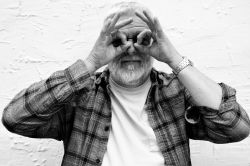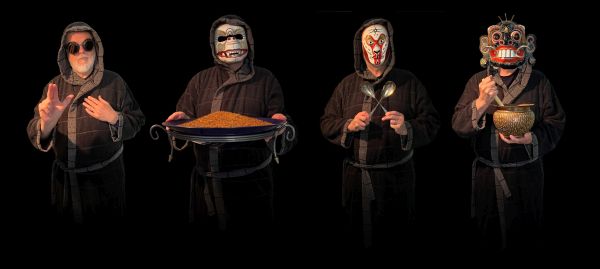M[m]: What are some of your earliest childhood musical memories?. And do you feel any of these triggered your love for the more quirky/avant-garde tastes?
Brian: Being a child of the 50s and 60s, it was pretty much the radio that initially shaped my musical world. From the Saturday morning Children’s Hour on the BBC in the 50s with its benign selection of kid-centric songs - though a few were a bit ‘different’ – one that sticks in mind is Sparky’s Magic Piano with this odd vocoder voice saying ‘play upon my keyboard Sparky’. Then in the early 60s listening furtively to Radio Luxembourg under the bed covers on a little transistor radio. That revealed new music to me albeit crackly and distinctly lo-fi.
I received my first record player at age 10 in 1963, pretty soon I settled on being a Stones fan. I used to sing along to my records (still do) and as a teenager my tastes sought out things that I thought stood apart from the mainstream – earlier Pink Floyd, mid-term Beatles, Beefheart, White Noise, Tonto’s Expanding Headband and of course Tyrannosaurus Rex….to name but a few.
In a strange way, thinking about it now, some of Tonto’s Expanding Headband reminds me of Sparky’s Magic Piano.
So, I tended to seek out music I’d not heard before – but paradoxically throughout I always kept a watchful ear on the pop music scene.

M[m]: you mention keeping a watchful ear on the pop music scene- do you still do this today, and if so, what has appealed/ interested you of late?
Brian: Ah, I should have qualified that I used to keep a watchful ear, probably drifted around 25 years ago.
Growing up I always avidly watched pop stuff on TV and, as a youngster, invariably bought pop singles, but less so as time went by. Around 14 years old in 1967, I became a lot more discerning, choosing albums and more obscure (non- mainstream) artists. But I still absorbed what was around on radio and TV. Also, as my two daughters were growing up, I became a lot more aware again of pop culture through their interests.
To quote The Residents’ maxim - ‘ignorance of your culture is not considered cool’…..so guess I did try to be informed.
My tastes are now completely eclectic – if it happens to come within earshot, I will happily listen to anything. Some I might like; some will go in one ear and out the other …. nowadays I think a lot more of the latter.
M[m]: What was your first sonic tool?, and do you still utilize it in your work today?
Brian: My first sonic tool was my voice which is still my primary instrument. OK I did try to learn recorder at school to no avail and didn’t touch an instrument again until I met up with David (Janssen) in 1969 and bought a guitar. We both learned (or unlearned) guitar together and played the instrument in our own way – I (and David) then tended to approach any instrument we got hold of in a similar way and let our naivety be a positive. I’d like to think that ethos still carries on even with the use of computers.
M[m]: Please talk a little bit about how you developed your distinctive singing style. And do you feel it’s altered/ changed over the years?
Brian: It was a mutual admiration for Tyrannosaurus Rex that brought David and I together. As a big fan, my singing style was very much influenced by that of Marc Bolan. His voice was different and, in many ways, unworldly. In the early 70s I was also into electric folk (Steeleye Span, Fairport Convention etc) and I found myself singing along to those records. In some ways that revealed my natural singing voice, it’s folksy with a slightly brash edge to it. I also like traditional folk music, particularly unaccompanied vocals - the singing of The Young Tradition still remains one of my favourite vocal textures. So I guess, I subconsciously combined Bolan and folk….with a Portsmouth accent!
That was then coloured by exposure to The Residents and, in some of their earlier work, the distinctly odd hi-pitched vocals. Oh…and possibly some world music textures too.
My voice has changed to a degree, it’s a consequence of getting older/old. The higher pitched vocals are just about possible but not every day – in fact my voice seems to change from day to day. I can now more readily do deeper vocals and, if I want, with a gravelly edge.
Some days I can almost do an impression of throat singing, but not polyphonic I hasten to add. However, the downside is it makes me cough if I attempt it for more than 20 secs!

M[m]: you talk about your love of folk music- have you ever thought of doing an acoustic folk album?
Brian: Specifically, a folk album? Short answer is no. However, trying ideas that are more acoustic based is appealing, that is if I can remember how to play the instruments I have.
M[m]: When did the idea of doing a solo album first come about?
Brian: As a serious project, only around November 2022. The sketches I made in the 90s and early 2000s had been the subject of a couple of previous attempts to finish them off – one in 2003 when Nolan Cook added his input to three pieces and also Mike Howlett, who I worked with on one other song. However, at the time, life events then got in the way, and I never completed those arrangements nor added vocals.
In 2017, I mentioned to Walter at Klanggalerie that I had a number of sketches and at his request I made demos of a few to play to him. He encouraged me to complete the project, but it took a further five years until I felt I had the headspace and energy to do it.
M[m]: Please talk a little bit about your songwriting process- both solo, and with others?
Brian: My solo songwriting process, based on the previous answer, must be extremely protracted! When Renaldo and The Loaf weren’t together, I found not having a sounding board in David, for what I might be coming up with, made me inherently unconfident, so songs remained as incomplete sketches. It’s fair to say that sporadically in the intervening years some notions of melody and lyrics did happen but only stayed as vague ideas.
When I decided to focus on finishing the songs, they seemed to crystalise quite quickly. I set myself deadlines by booking studio time each month to mix a song or two and that pressure helped a lot.
When collaborating with others I find it a lot easier – there’s a chance to share ideas, react to feedback etc. The more recent collaborations have mainly seen me provide vocals for other people’s projects, such as for Alieno De Bootes Unconventional Residents 3 and Alex Wroten’s Gatekeepers series.
M[m]: Could you discuss the meaning behind They Blessed The Body Breadcrumbed title?
Brian: The phrase that became the title is one I’d noted down some years ago. I’d read a piece about Sin Eaters – this was a practice undertaken from medieval times onwards until the early 19th century in some communities. A person, invariably someone poor, would be paid by a richer family to sit by a body in church to ritually consume bread in order to absorb the unconfessed sins of the deceased. This would speed the soul’s ascent to heaven. Sometimes the bread would also be sat on the body on a plate of salt.
I took the idea and bounced it sideways to involve the breadcrumbing of a (live) body in some other (undefined) ritual.
M[m]: It’s fair to say They Blessed The Body Breadcrumbed is a wonderful varied & unpredictable record- with the track listing layout working perfectly. How long did it take you to sequence the record?
Brian: I’m pleased you think the track list works well. Really it didn’t take too long to sequence – early on I’d determined that the opening and closing tracks, which allude more to the ritual, would bracket the album. The two Blessing Chant interludes, which hint back to the ritual, I placed to create three segments in which to balance the remaining songs.
It was then just a case of figuring out what sounded best – when all the tracks were done, Jonny Callender, who mixed and mastered the album, suggested swapping a couple of tracks around for better dynamic effect and also a friend, Jez Stevens, recommended Window And The Wall be placed towards the end of the album as he felt it was a strong track which he said would make him want to play it all through again.
M[m]: They Blessed The Body Breadcrumbed features a few collaborations on tracks- do you have any dream collaborators you’d like to work with?
Brian: Yeah, Ed Sheeran (ha ha) – that way the song would get a phenomenal amount of exposure!
Seriously, I don’t think (yet) I’ve deliberately reached out to request a collaboration. Those I’ve done have come about more casually as the other artist has kindly offered to work with me (Nolan Cook, Mike Howlett) or I’ve been invited to participate on others’ projects – largely to provide vocals.
The collaboration with Frank Pahl just happened when he visited me for a weekend in 1997….he added lyrics and banjo to a piece I was working on at the time.
M[m]: Some of the album's tracks blend together 90’s midi recordings with more modern elements/ production. How difficult was it to balance these elements?, and please could you talk about the album's production in general?
Brian: The majority of the songs have a 90s midi basis. They were constructed in Cubase, however I could not recreate them years later as the more modern versions of Cubase don’t support the file types I had plus, I don’t still have all the original outboard equipment for sound generation.
In the late 90s when I upgraded my hardware and software, I did think to make stems of a couple of songs, however the majority existed only as historic mixes saved to cassette which I digitised. So those mixed sketches were quite inflexible – I could edit audio and adapt the arrangements if I wanted, but relative levels and sound quality were fixed. Luckily the audio and mixes were pretty good and could be tweaked a bit by Jonny Callender in the studio as necessary.
The sketch mix made by Mike Howlett for Trichophobe was, as you would expect, high quality so I was able to tackle that one with confidence. The songs with stems, of course, offered more flexibility.
Blessing Song was the exception to the above - it was initially recorded in 2011 using FL Studio as a backing for a collaboration with the New York artist, Michael Alen Alien. I later revisited it and made it into a song.
Vocals were mainly recorded in 2017 and 2023 in my home studio as were some bass overdubs and acoustic instruments – balancing them to the backings was not too difficult. Jonny added live drums to enhance a couple of tracks during the mixing stage and my friend Clair Wheeler added some backing vocals to When Mephisto Tangos.
M[m]: Among the different types of tracks on the album we have a surprising ethnic percussion pop tune in the shape of “The Window And The Wall”. Any thoughts on releasing this as a single?
Brian: That has also been suggested by a few friends – I gave it some thought and even considered what might make up the ‘B’ side. That included one unreleased song from the early 2000s, a cover of Buddy Holly’s Rave On. I’m not too sure how to go about releasing it as a single – OK, digitally I guess but my mind immediately goes to a 7” but, how to make such a thing available, I don’t know? I haven’t really got the time right now to consider self-releasing something.

M[m]: You’ve released one video single from the album thus far The Blessing Song, what made you select that song? And please talk a little bit about how the video was created?
Brian: It was the song that I had the strongest visual ideas for…. the breadcrumbing scenario, props like the masks for the ritual characters etc. However, it was Alex Wroten’s involvement that made it gel and become technically feasible.
During a casual chat with Alex, I mentioned in passing that I had some ideas about a video. Alex then generously offered to work with me on a storyboard and to direct it. It was decided that the majority would be filmed here in Portsmouth with some sequences done in the US. I bought a green screen kit and Jez Stevens (who filmed and directed the RATL Convivial Ode video) came on board to do the filming, assisted by Clair Wheeler. Jez also enabled the production as he arranged lighting and the venue.
It was an intense and hot day, with the directing list requiring multiple shots. On the day, I was well overheated, playing all the parts mainly wearing a thick dressing gown (inside out) on a scorching day, under lights! The breadcrumbed person, actor David Gwaltney, was filmed in the US and incorporated through Alex’s skilful editing and direction.
The opening and closing shots were filmed at St. Huberts, a Saxon-Norman church dating from 1053 near Idsworth in Hampshire. The interior in the video is not of that church but is AI generated.
M[m]: Any thoughts on any other singles from the album? And if so any visual ideas?
Brian: Other singles, not really, apart from Window and The Wall as mentioned elsewhere in this interview. As to videos, no specific thoughts as I’ve had little or no time to devote to it – would perhaps be more interesting to me if someone else was inspired by a particular song to come up with some visual ideas.
M[m]: Have you started work on any new solo work yet, and was there anything that wasn’t released on They Blessed The Body Breadcrumbed?
Brian: I haven’t yet considered any new solo work. There are no unreleased tracks available (apart from Rave On). I have a few other old midi sketches that have not yet been developed but I have no immediate plans to work on them.
M[m]: Any thoughts of performing live solo?, and if so, have you ever envisaged what it might look like?
Brian: No. I guess my thoughts on live performance would parallel those David and I encountered as Renaldo & The Loaf. Just me standing there singing to a laptop backing wouldn’t, I think, be interesting enough for the audience or me. When we did our one and only live show in Vienna, we had some great visuals backing it up and David learned to play his midi-clarinet specifically so he could actively perform – which worked very well.

M[m]: Any updates on new Renaldo and the Loaf material? And what else are you working on a present?
Brian: At present, for me, new music work has been parked – we are working towards moving house later this year and that’s taking up a lot of my time – decorating, sorting stuff out and stealing myself to confronting the whole rigmarole of moving us from the house we’ve lived in for 36 years! I certainly look forward to resuming some music work once we’re settled elsewhere and my studio is reconstructed.
There is no news to impart regarding new RATL material – as we always say, it will happen when (and if) it happens. This year will potentially see a re-issue of Arabic Yodelling on remastered vinyl including the bonus material, Grain By Grain (For Accuracy). The plan is to complement the earlier two vinyl re-issues by Editions Mego.
Also, there are plans for They Blessed The Body Breadcrumbed to get a vinyl release later this year.
M[m]: What has made an impact on you over the last six or so months- be it music, art, film, or TV shows?
Brian: Hmmm…I find questions like this a bit difficult to answer – of the stuff I listen to, read or watch, I enjoy some of it, although I’m not sure much of it ‘impacts’ me a great deal.
That being said the latest things I’ve enjoyed or are enjoying…. Music: The Hu albums, Rumble of Thunder + Gereg. Book: Red Side Story by Jasper Fforde, TV: Fallout and 3 Body Problem.
In terms of life, there has been something that I can confidently say has made an impact on me (and a lovely one too) …the recent arrival of our second grandson, Joshua!
A big thanks to Brian for his time and efforts with the interview. They Blessed The Body Breadcrumbered can be purchased directly here https://www.klanggalerie.com/gg454
photo credits: first & last pics Gill Poole , and the other three Paul Windsor

